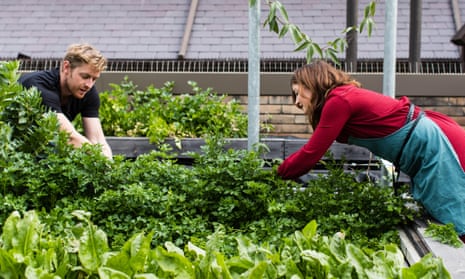Wednesday is harvesting day on the rooftop garden at St Canice’s Church in Sydney’s Kings Cross. Tending the garden’s array of vegetables, flowers and herbs are groups of mental health patients from a nearby hospital.
The simple act of being out in the open air and in contact with nature acts like therapy, says project coordinator Rob Caslick. To prove the point, he invited a research team from the hospital to monitor the patients’ progress. “It’s only once a week in a garden but people report feeling much more positive … The clinicians were really surprised just how much people opened up to them while they were gardening,” says Caslick, who runs a soup kitchen in the same building. The benefits of contact with nature – technically known as biophilia – are becoming increasingly well documented. One well-known study showed how hospital patients with a view of trees from their ward window recovered more quickly than those without such a view.
Yet since Edward Wilson popularised the term biophilia (literally, “love of life or living systems”) back in the early 1980s, uptake of the idea in Australia has been piecemeal.
“True biophilic design really plays with all your five senses, which is why it can be so powerful … but it’s still not a topic or a terminology that is very well known or discussed,” says Caroline Pidcock, a Sydney-based architect and leading proponent of nature-inspired design.
There are signs that this could be beginning to change. Take Defence Housing Australia (DHA). Hardly a hippy house-builder, DHA manages a $10.6bn property portfolio. Even so, its new 152-apartment complex in Alexandria is set to be equipped with a “pocket park” and barbecue spaces, rooftop gardens, chicken runs and even an apiary (you know: for bees).
DHA’s Arkadia development, which is currently under construction, is inspired by the belief that “functional seasonal landscapes” will generate a sense of community and enhanced wellbeing. With so much nature on their doorstep, its future service personnel residents will feel compelled to “step outside and interact with one another”. So the government enterprise’s marketing blurb promises at any rate. Another new development with similar blue sky (and green wall) ambitions is Sydney’s One Central Park. Described as a “bouquet to the city”, the development’s two residential towers are topped with terrace gardens and shrouded from top to bottom in green foliage. Attractive though biophilic design may be, it has to make business sense if it stands any chance of going mainstream.

Frasers Property Australia, one of the developers of the One Central Park project, seems persuaded. The property giant is currently ploughing millions of dollars into a biophilically inspired 22ha mixed retail-residential development in Melbourne’s East Burwood suburb. The project incorporates ecological features put forward as part of a design competition run by Australia’s Living Futures Institute.
The winning suggestions carry with them a compelling business rationale, says Pidcock, who sits on the institute’s board: “Frasers will get much higher rents because the people coming to this shopping centre will – because it’s going to be beautiful and biophilically designed – probably spend more time there.”
Dr Omniya el-Baghdadi at the Queensland University of Technology agrees that a sound business case for biophilia is necessary but is under no illusion about the challenges of winning over big business. And this is from someone who devoted an entire PhD to the subject. El-Baghdadi’s research draws on insights from ecological economics, focusing in particular on the “ecosystem services” that nature-based architecture offers (think enhanced air quality or natural cooling). Behavioural economics provides another layer to her argument; notably, the psychological upsides that biophilic design brings.
Persuasive though this all looks on paper, convincing supporters in the hard-nosed world of business remains an uphill battle. “It’s really hard to change the status quo,” El-Baghdadi says. “We’re creatures of habit, so once we know how to build something we tend to stick to it.”

The failure of neoclassical economics to factor in the less tangible benefits of biophilia represents an even harder nut to crack. For that reason, landscape design is never given the appreciation it deserves, she says. Take an urban park. It may well encourage city dwellers to take more exercise and socialise more. Yet, because such outcomes don’t convert easily into dollars and cents, the value of that park is overlooked.
As El-Baghdadi says: “The economic conversation as it stands today is really quite reductionist. We need to recognise that biology and psychology play a massive role and yet these do not feature in our current decision-making processes.”
This battler for biophilia is not without optimism, however. She cites the example of the construction firm Lendlease Australia, which recently commissioned QUT to assess the business benefits of green infrastructure innovations at a major construction site near Brisbane. The six-month study will track factors such as energy saving, individual wellbeing and other “end-user experiences”.
“A massive construction company like Lendlease could make a huge impact on its industry,” she says.
Back at St Canice’s, meanwhile, Caslick wishes the QUT researchers every success in bolstering the economic case for biophilia. Not that it will sway his personal opinion very much.
“I’m the least fluffy person I know – but just seeing the interaction of people around the roof garden, it’s so levelling,” he says. “You can’t really measure it. You’ve just got to try it for yourself.”

Comments (…)
Sign in or create your Guardian account to join the discussion